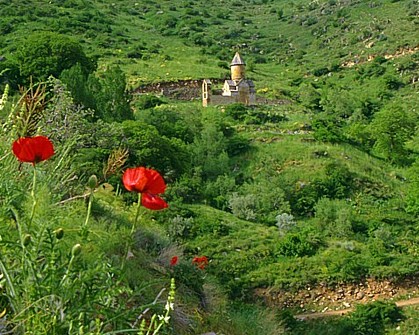![]()
![]()
NATURAL ZONES
Because of the complex relief changes in the natural conditions of the
Republic occur at every step: each mountain range or canyon, each plateau or
mountain peak brings new types and subtypes of soils, vegetation and species of
animals.
Though small, Armenia has twice as many types of soil as the vast territory of
the European part of Russia and the Ukraine (about 5 million sq. km), several
more varieties of vegetation and no fewer species of animals.
The soil map of Armenia is surprising for its extraordinary variety of
colors: it shows some 15 types and 40 subtypes of soils. But it is immediately
noticed that the map repeats the main outlines of the relief. The thickest layer
of fertile soils has formed in the wide valleys and on the flat plateaus, i.e.,
in places of accumulation of small-grained deposits. Coarse (skeleton) shallow
soils from which the fine earth is washed out prevails higher up, on the
mountain slopes. The genetic type of soils also changes with elevation; this was
first noted by V. V. Dokuchayev, well-known Russian soil scientist who visited
Armenia at the end of the last century.
Man 's agricultural activities over thousands of years have greatly affected the
soil.
But the diversity of the vegetable and animal kingdom of the Armenia is due not only to the complex relief, soils and climate, but also to the location of the Armenian Plateau at the junction of different biogeographical provinces. Here the xerophilous flora of the Iranian Plateau mixes with the comparatively hydrophilous Caucasian species. Armenia 's plants include many diverse species (almost 3,200). There are more than 100 different species of plants per 1,000 sq. km of its territory, whereas in the former USSR as a whole there was only one species.

According to Academician N. I. Vavilov, one of the most eminent Soviet scientists, many puzzles of the origin of cereals were solved by studying the flora of South-West Asia. It was demonstrated, for example, that rye originated in Armenia. The Armenian Highland and all of South-West Asia are the birthplace of grapes, pears, quince, almonds and figs. Many fodder grasses were first grown in these areas. The origin of the famous cantaloupe was traced to the Van area.
Among the most widespread plants in Armenia is upland xerophytic vegetation (prevailing in droughty areas) particularly in places where, owing to very pervious rocks, the surface of the territory is deficient in water or where a good deal of moisture evaporates from the exposed rocky mountain slopes. The southern slopes, especially in the central and southeastern parts of the Republic are the most arid. During the latest, more droughty period the upland xerophytic vegetation has spread still more; this process has been encouraged by man cutting down the forests. The forests have been replaced by more tenacious and viable drought-resistant semi-desert and steppe plants. The most characteristic forms of upland xerophytes are the pillow-like and prickly under shrubs such as the milk vetch. They have long roots that reach down to the moist layers of the subsoil. The pillow-like crowded stalks and thorns of the milk vetches retain a uniform temperature, which lessens evaporation. Wormwood, another underbrush and principal species of the semi desert flora, is also widespread. Characteristic of the shrub forms is the thorn which in some places forms continuously prickly thickets. Many forests were destroyed over a period of many centuries, especially during feudalism and capitalism, though some have since then been replanted.
Because of the complexity of the relief, climate and vegetation the Republic has a rich fauna which includes more than 450 species of vertebrates - 70 species of mammals, 300 of birds (more than 100 of these are wintering species), 40 of reptiles (some 20 species of snakes), 23 of fish and 5 of amphibians. There are almost 10,000 species of insects and more than 1,000 species of other invertebrates. Many of these are endemic. Hunting was an auxiliary occupation of the ancient Armenian tribes. The excavations of Teishebaini, an Araratian fortress, have revealed that they ate the flesh of deer, gazelles, wild sheep, bezoar goats and various wild birds.
In addition to tilling land the Armenians bred cattle as far back as 3,000
years ago, especially in the mountainous areas. Sheep breeding reached a
particularly high stage of development, and many breeds of sheep - Mazekh,
Balbas, Karabakh and Bozakh were raised in Armenia.
